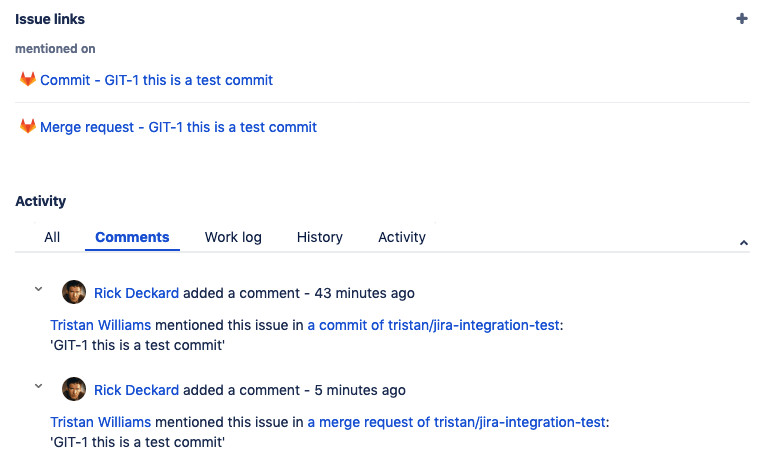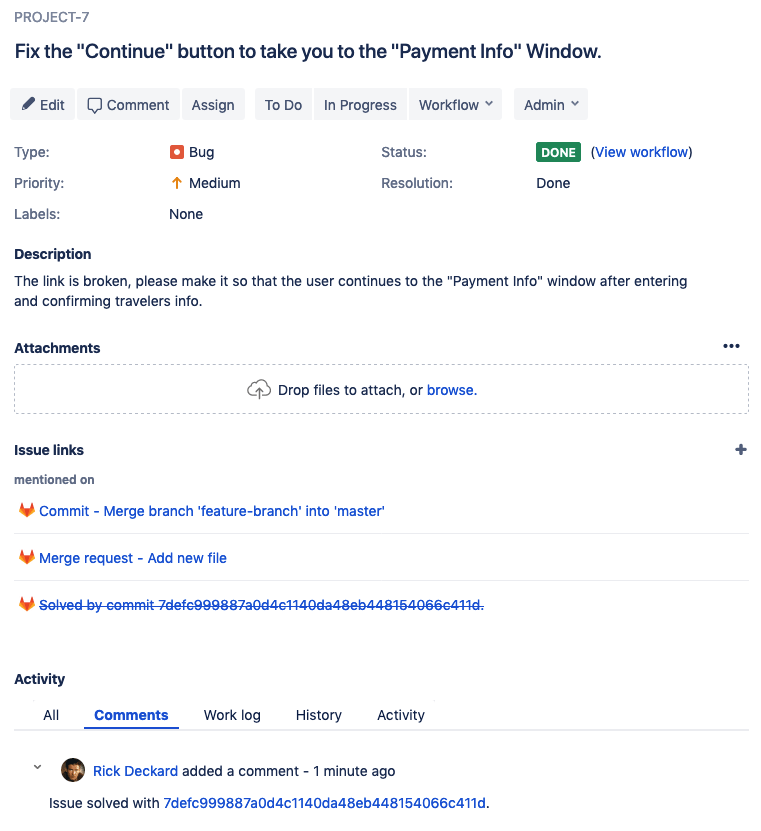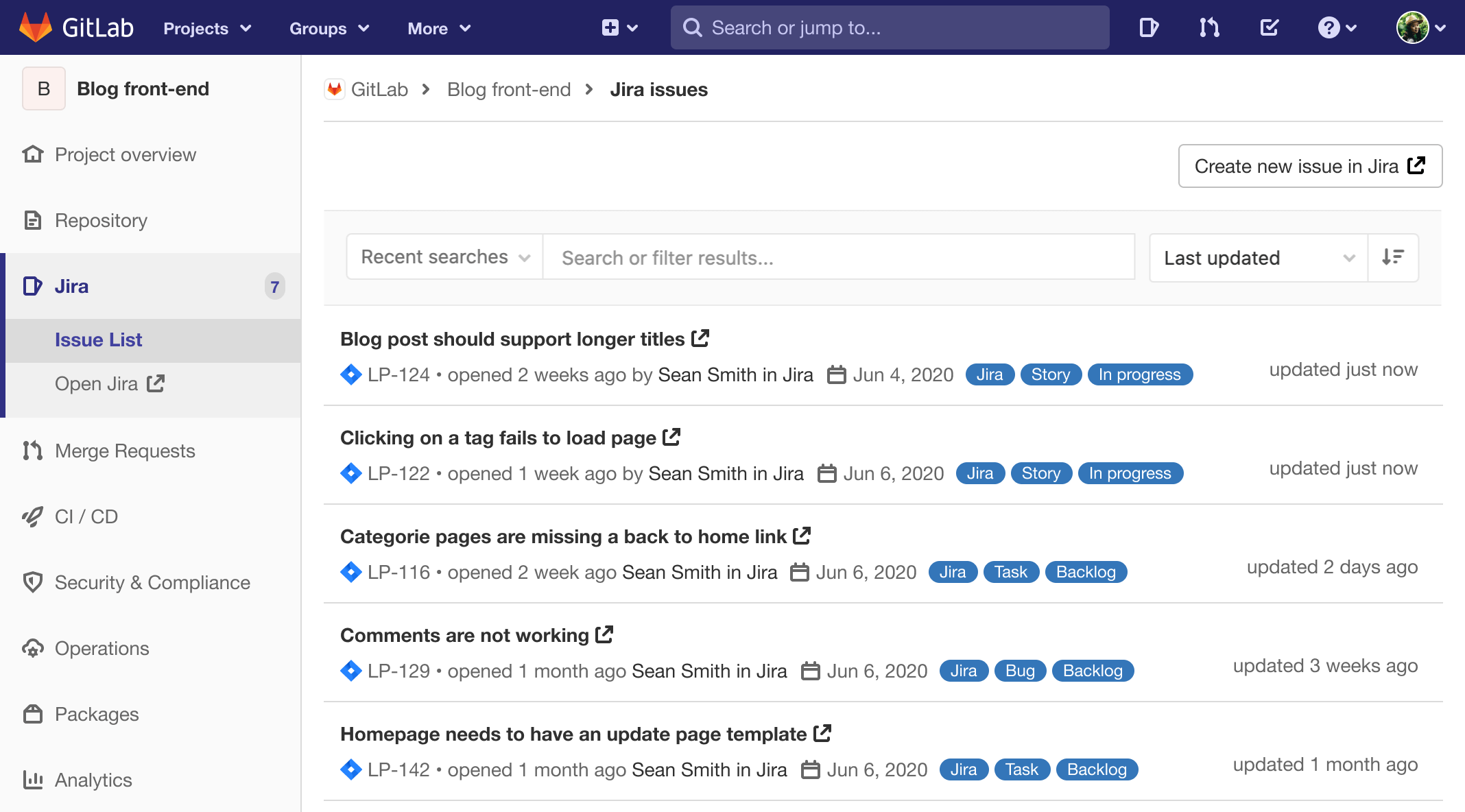7.9 KiB
| stage | group | info |
|---|---|---|
| Create | Ecosystem | To determine the technical writer assigned to the Stage/Group associated with this page, see https://about.gitlab.com/handbook/engineering/ux/technical-writing/#assignments |
Jira integration issue management (FREE)
By now you should have configured Jira and enabled the Jira service in GitLab. If everything is set up correctly you should be able to reference and close Jira issues by just mentioning their ID in GitLab commits and merge requests.
Jira issue IDs must be formatted in uppercase for the integration to work.
Reference Jira issues
When GitLab project has Jira issue tracker configured and enabled, mentioning
Jira issues in GitLab automatically adds a comment in Jira issue with the
link back to GitLab. This means that in comments in merge requests and commits
referencing an issue, PROJECT-7 for example, adds a comment in Jira issue in the
format:
USER mentioned this issue in RESOURCE_NAME of [PROJECT_NAME|LINK_TO_COMMENT]:
ENTITY_TITLE
USERA user that mentioned the issue. This is the link to the user profile in GitLab.LINK_TO_THE_COMMENTLink to the origin of mention with a name of the entity where Jira issue was mentioned.RESOURCE_NAMEKind of resource which referenced the issue. Can be a commit or merge request.PROJECT_NAMEGitLab project name.ENTITY_TITLEMerge request title or commit message first line.
For example, the following commit references the Jira issue with PROJECT-1 as its ID:
git commit -m "PROJECT-1 Fix spelling and grammar"
Close Jira issues
Jira issues can be closed directly from GitLab by using trigger words in commits and merge requests. When a commit which contains the trigger word followed by the Jira issue ID in the commit message is pushed, GitLab adds a comment in the mentioned Jira issue and immediately closes it (provided the transition ID was set up correctly).
There are currently three trigger words, and you can use either one to achieve the same goal:
Resolves PROJECT-1Closes PROJECT-1Fixes PROJECT-1
where PROJECT-1 is the ID of the Jira issue.
Note the following:
- Only commits and merges into the project's default branch (usually
master) close an issue in Jira. You can change your project's default branch under project settings. - The Jira issue is not transitioned if it has a resolution.
Let's consider the following example:
- For the project named
PROJECTin Jira, we implemented a new feature and created a merge request in GitLab. - This feature was requested in Jira issue
PROJECT-7and the merge request in GitLab contains the improvement - In the merge request description we use the issue closing trigger
Closes PROJECT-7. - Once the merge request is merged, the Jira issue is automatically closed with a comment and an associated link to the commit that resolved the issue.
In the following screenshot you can see what the link references to the Jira issue look like.
Once this merge request is merged, the Jira issue is automatically closed with a link to the commit that resolved the issue.
View Jira issues (PREMIUM)
Introduced in GitLab Premium 13.2.
You can browse, search, and view issues from a selected Jira project directly in GitLab, if your GitLab administrator has configured it:
-
In the left navigation bar, go to Jira > Issues list.
-
The issue list sorts by Created date by default, with the newest issues listed at the top:
-
To display the most recently updated issues first, click Last updated.
-
In GitLab versions 13.10 and later, you can view individual Jira issues.
Issues are grouped into tabs based on their Jira status:
- The Open tab displays all issues with a Jira status in any category other than Done.
- The Closed tab displays all issues with a Jira status categorized as Done.
- The All tab displays all issues of any status.
View a Jira issue
- Introduced in GitLab Premium 13.10 behind a feature flag, disabled by default.
- Feature flag removed in GitLab Premium 13.11.
When viewing the Jira issues list, select an issue from the list to open it in GitLab:
Search and filter the issues list
To refine the list of issues, use the search bar to search for any text contained in an issue summary (title) or description.
You can also filter by labels, status, reporter, and assignee using URL parameters. Enhancements to be able to use these through the user interface are planned.
-
To filter issues by
labels, specify one or more labels as part of thelabels[]parameter in the URL. When using multiple labels, only issues that contain all specified labels are listed./-/integrations/jira/issues?labels[]=backend&labels[]=feature&labels[]=QA -
To filter issues by
status, specify thestatusparameter in the URL./-/integrations/jira/issues?status=In Progress -
To filter issues by
reporter, specify a reporter's Jira display name for theauthor_usernameparameter in the URL./-/integrations/jira/issues?author_username=John Smith -
To filter issues by
assignee, specify their Jira display name for theassignee_usernameparameter in the URL./-/integrations/jira/issues?assignee_username=John Smith
Automatic issue transitions
Introduced in GitLab 13.10.
In this mode the referenced Jira issue is transitioned to the next available status with a category of "Done".
See the Configure GitLab section, check the Enable Jira transitions setting and select the Move to Done option.
Custom issue transitions
For advanced workflows you can specify custom Jira transition IDs.
See the Configure GitLab section, check the Enable Jira transitions setting, select the Custom transitions option, and enter your transition IDs in the text field.
If you insert multiple transition IDs separated by , or ;, the issue is moved to each state, one after another, using the given order. If a transition fails the sequence is aborted.
To see the transition IDs on Jira Cloud, edit a workflow in the Text view. The transition IDs display in the Transitions column.
On Jira Server you can get the transition IDs in either of the following ways:
- By using the API, with a request like
https://yourcompany.atlassian.net/rest/api/2/issue/ISSUE-123/transitionsusing an issue that is in the appropriate "open" state - By mousing over the link for the transition you want and looking for the "action" parameter in the URL
Note that the transition ID may vary between workflows (for example, bug vs. story), even if the status you are changing to is the same.
Disabling comments on Jira issues
You can continue to have GitLab cross-link a source commit/MR with a Jira issue while disabling the comment added to the issue.
See the Configure GitLab section and uncheck the Enable comments setting.




